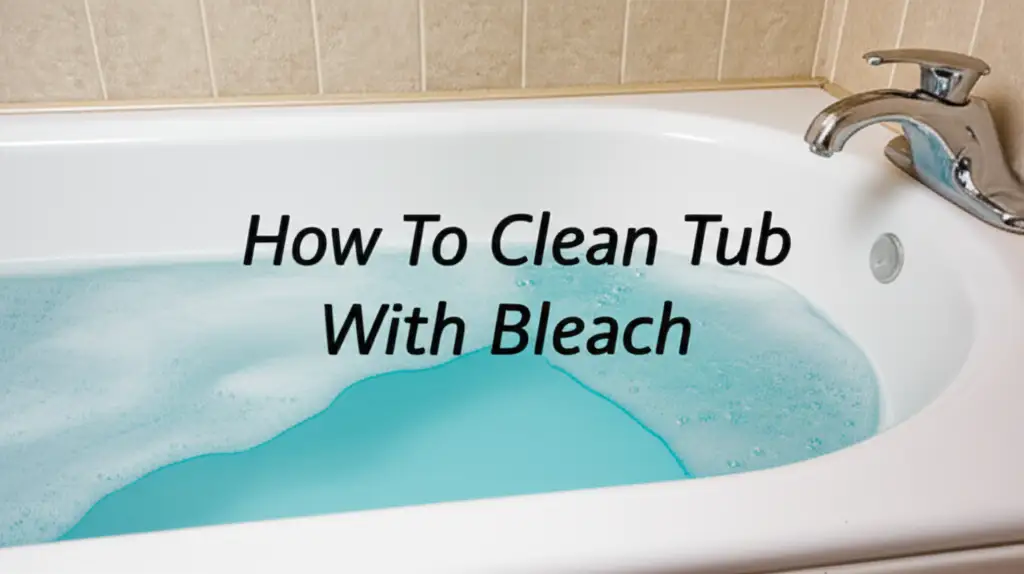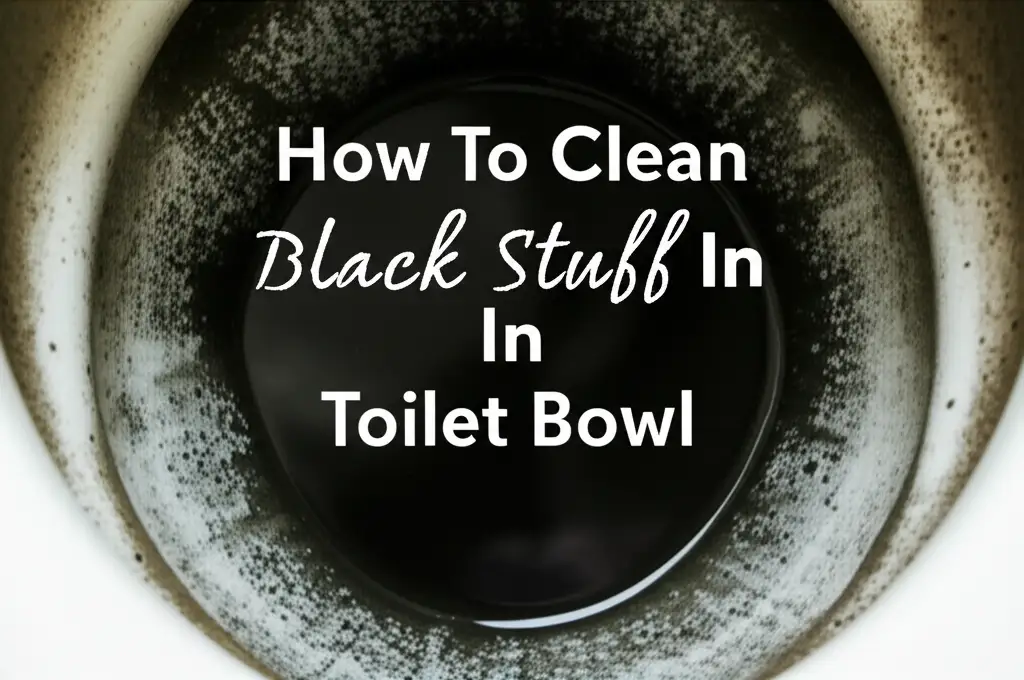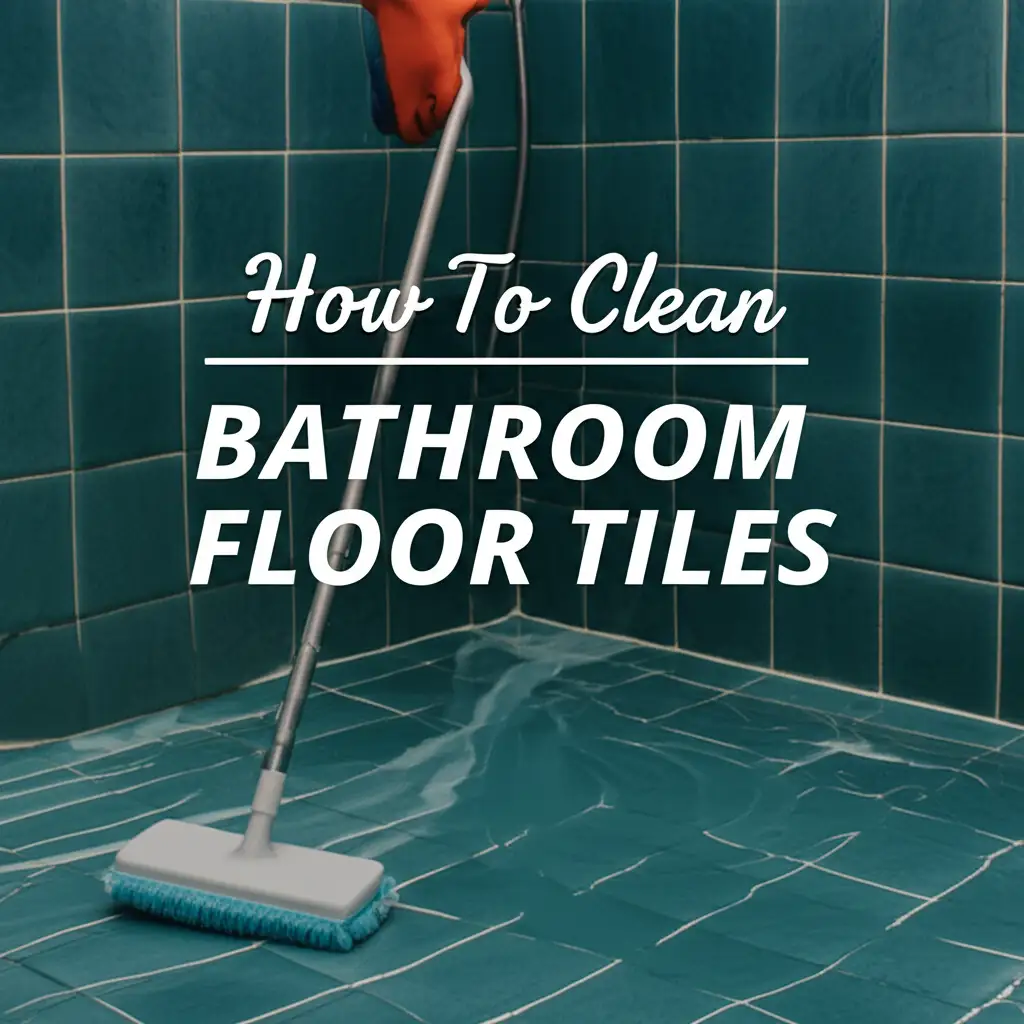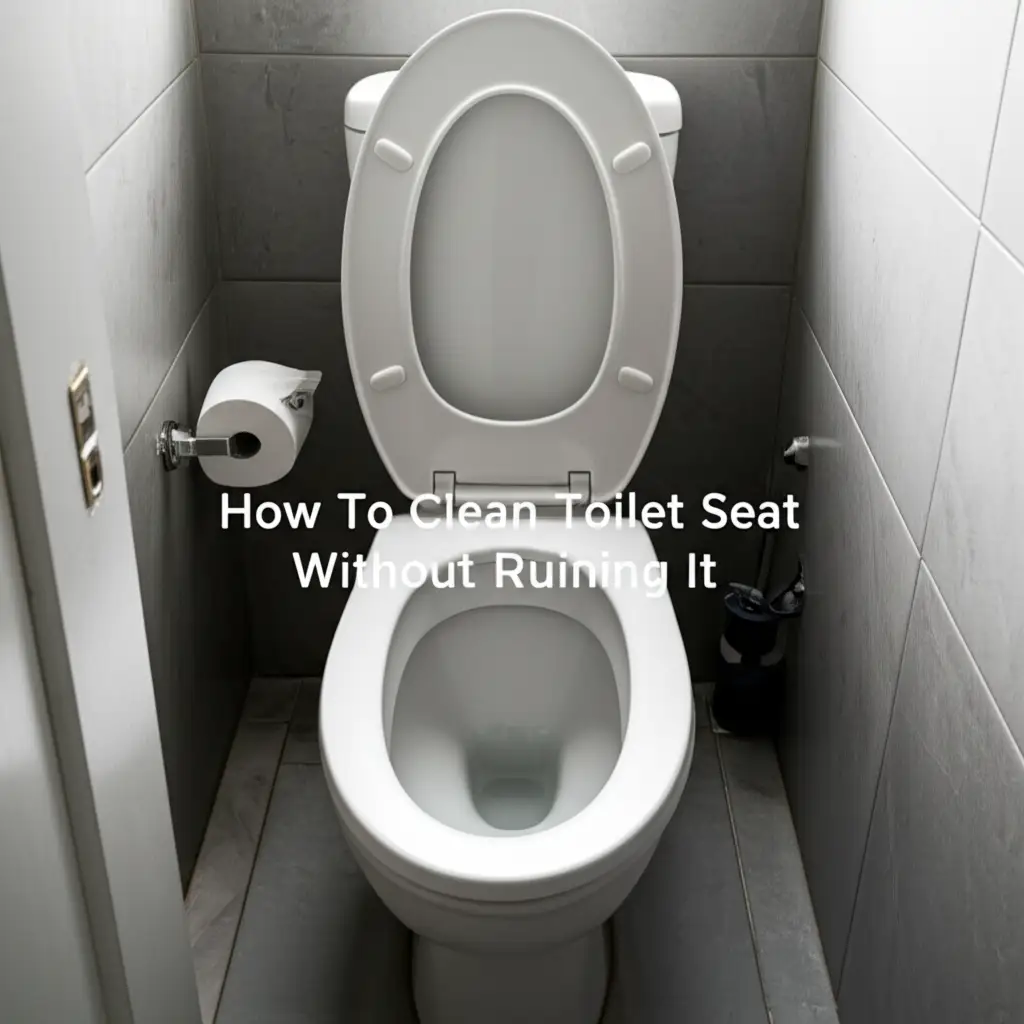· Bathroom Cleaning · 18 min read
How To Clean Tub With Bleach

How to Clean Your Tub with Bleach: A Comprehensive Guide
My bathroom tub is often one of the dirtiest spots in my home. It sees daily use, accumulating soap scum, grime, and even mildew. Many cleaning products exist, but sometimes, a powerful disinfectant like bleach is the best option. Bleach offers strong sanitizing properties and helps lift tough stains effectively.
Cleaning your tub with bleach requires care. You need to understand proper dilution, ventilation, and safety precautions. This guide provides a detailed walkthrough for using bleach to get your tub sparkling clean. We will cover preparation, application, rinsing, and important safety measures. By following these steps, you can achieve a hygienic and bright tub surface.
Takeaway
- Always prioritize safety with bleach; wear gloves and eye protection.
- Ensure good ventilation by opening windows or using a fan.
- Dilute bleach properly before application to avoid damage and ensure safety.
- Apply bleach solution to specific areas, let it sit briefly, then scrub.
- Rinse the tub thoroughly multiple times to remove all bleach residue.
Clear, Concise Answer to the Main Query
To clean a tub with bleach, first ensure good ventilation and wear protective gear. Dilute household bleach with water (usually 1:10 ratio). Apply the solution to the tub surface, allow it to sit for a few minutes, scrub stubborn areas, and then rinse thoroughly with water.
Prioritizing Safety When Using Bleach in Your Bathroom
Using bleach is an effective way to clean your tub, but it demands strict safety measures. Bleach is a powerful chemical. It can cause irritation to skin, eyes, and respiratory passages if not handled correctly. Your health is the most important thing. I always make safety my top priority before I even open the bleach bottle.
Proper ventilation is the first step. Open all windows in your bathroom. Turn on the exhaust fan if you have one. This helps remove bleach fumes from the air. Fumes can be strong and unpleasant, causing discomfort or breathing issues. Air circulation keeps you safe while you work.
Protecting your skin and eyes is also critical. Wear sturdy rubber gloves to prevent direct skin contact. Bleach can dry out or irritate your skin. Goggles or safety glasses are a must to shield your eyes from splashes. A small splash can cause significant irritation. Never forget these simple protective items.
You should never mix bleach with other cleaning agents. Especially avoid mixing it with ammonia-based cleaners or acids, like vinegar. Combining these creates dangerous gases. These gases are toxic and can cause serious health problems. Always use bleach by itself, or with plain water.
Store bleach safely after use. Keep it in its original container. Store it in a cool, dry place away from direct sunlight. Make sure it is out of reach of children and pets. Proper storage prevents accidents and maintains the bleach’s effectiveness.
Gathering Your Essential Cleaning Supplies
Before you begin cleaning your tub, you need to collect all necessary items. Having everything ready makes the cleaning process smoother and more efficient. It also helps you avoid stopping midway to search for a tool. I like to lay everything out on a towel just outside the tub.
First, you will need a bottle of household bleach. Standard liquid chlorine bleach works best for tub cleaning. Do not use color-safe bleach or oxygen bleach for this purpose. Their chemical composition is different and they will not provide the same sanitizing power. Choose a fresh bottle for best results.
You also need a clean bucket or a spray bottle for mixing the bleach solution. A bucket is good for larger areas, allowing you to dip a sponge. A spray bottle is useful for targeting specific spots or getting an even mist. Make sure the container is clean and used only for cleaning products.
For scrubbing, gather a few tools. A soft-bristled scrub brush is ideal for the main tub surface. You might also want an old toothbrush or a small detail brush for tight corners and grout lines. Avoid abrasive scrubbers like steel wool. These can scratch your tub’s finish.
Don’t forget clean cloths or sponges. These are for wiping surfaces and rinsing the tub. Microfiber cloths are absorbent and non-abrasive. Having several on hand is helpful. You will use some for applying the solution and others for rinsing.
Finally, have access to plenty of fresh water. You will need it for diluting the bleach and for thorough rinsing. Make sure your faucet provides hot and cold water. This helps with dissolving soap scum and rinsing away residue.
Preparing Your Tub and Bathroom Space
Proper preparation is key to an effective and safe tub cleaning experience with bleach. Before you introduce any cleaning agents, you need to set the stage. This initial work helps the bleach solution perform its best. It also protects your bathroom from accidental damage.
Start by removing all items from your tub and shower area. This includes shampoo bottles, soaps, bath toys, and washcloths. You want a completely clear surface to work on. These items can get in the way and might become bleached if exposed. Place them in a safe spot outside the tub.
Rinse the tub with warm water. This removes any loose dirt, hair, or surface grime. A quick rinse helps the bleach solution make direct contact with the stains and soap scum. It also pre-wets the surface, which can sometimes help the bleach spread evenly. Use your showerhead to spray down all tub surfaces.
Protect nearby surfaces that might be sensitive to bleach. If you have a shower curtain, move it aside or remove it completely. Bleach can damage fabric and colored towels. Ensure rugs or bath mats are not near the tub. If your bathroom floor is delicate, lay down old towels or plastic sheets.
Consider the material of your tub. Bleach is generally safe for porcelain, ceramic, and fiberglass tubs. However, avoid using bleach on natural stone tubs (like marble or granite). Bleach can pit or discolor these materials. If you have a painted tub, test a small, hidden spot first.
Lastly, double-check your ventilation. I cannot stress this enough. Ensure windows are open wide and the exhaust fan is running. Good airflow prevents the buildup of strong bleach fumes. This simple step protects your respiratory health while you clean.
Diluting Bleach for Safe and Effective Cleaning
Correctly diluting bleach is perhaps the most important step for safe and effective tub cleaning. Using undiluted bleach can be too harsh. It can damage your tub’s surface or leave streaks. It also creates stronger, more irritating fumes. I always make sure to get this ratio right.
For general tub cleaning, a common and effective dilution ratio is 1 part bleach to 10 parts water. For example, if you use one cup of bleach, you will add ten cups of water. This creates a solution strong enough to sanitize and lift stains without being overly aggressive. Always add bleach to water, not water to bleach.
Measure your ingredients accurately. Use a measuring cup for both bleach and water. Pour the measured water into your clean bucket or spray bottle first. Then, carefully add the measured bleach. Stir the solution gently if using a bucket. If using a spray bottle, cap it and swirl it to mix. Do not shake vigorously, as this can create foam and fumes.
For very tough stains or stubborn mold, you might slightly adjust the ratio. You could use 1 part bleach to 5 parts water for these specific areas. However, this stronger concentration should only be used as needed. Apply it only to the affected spot. Always rinse these areas even more thoroughly afterwards. For general mold issues, you might find specific guidance on how to clean mold with bleach helpful.
Never use bleach at full strength on your tub. It is unnecessary and risky. Full-strength bleach can strip finishes from some tub materials. It can also leave behind a sticky residue. Dilution maximizes its cleaning power safely. Remember that a little bleach goes a long way.
Prepare the solution fresh each time you clean. Bleach solutions lose their potency over time. A freshly mixed solution guarantees maximum effectiveness. Do not store leftover diluted bleach. Dispose of it properly by pouring it down the drain with plenty of water.
Applying the Bleach Solution to Your Tub
Once your bleach solution is ready, it’s time to apply it to the tub. This step needs care to ensure even coverage and effective stain removal. I find that the method of application can make a big difference in the final results. Choose the best method for your specific tub and cleaning needs.
You have a few options for application. If you are using a spray bottle, mist the entire surface of the tub. Work from top to bottom, ensuring even coverage. A fine mist is usually sufficient. Avoid over-saturating the surface. This method is good for general cleaning and sanitizing.
If you are using a bucket, you can use a clean sponge or a soft cloth. Dip the sponge into the diluted bleach solution. Wring out any excess liquid. Then, wipe down all surfaces of the tub, including the sides, bottom, and around the drain. Ensure every area receives a thin, even layer of the solution.
For areas with specific issues like mold or stubborn grime, you might need a more targeted approach. For instance, if you see mold on the shower walls that extends into the tub, refer to tips for how to clean mold in shower. For persistent soap scum or dark stains, let the solution sit for a short period. I usually let it sit for about 5 to 10 minutes. This allows the bleach to break down the grime effectively. Do not let the solution dry on the tub surface.
After the short dwell time, it’s time to scrub. Use your soft-bristled scrub brush. Gently scrub all surfaces of the tub. Pay extra attention to problem areas. The scrubbing action helps to dislodge loosened dirt and soap scum. It also helps work the bleach deeper into surface stains. For the textured bottom of some tubs, a good scrub can reach into crevices. If your tub has a textured bottom, specific advice on how to clean fiberglass tub with textured bottom might also be useful.
Work methodically around the tub. Ensure you do not miss any spots. Keep the area well-ventilated throughout this process. The scrubbing can release more fumes. After scrubbing, the tub should look noticeably cleaner.
Tackling Stubborn Stains and Mold with Bleach
Tubs often develop stubborn stains and mold buildup, especially in humid bathroom environments. Bleach is highly effective against these persistent issues. Targeting these areas precisely can restore your tub’s pristine appearance. I’ve found that a bit of focused effort here yields the best results.
For tough stains like hard water spots or rust (if not too severe), a slightly stronger bleach solution may be needed. As mentioned earlier, a 1:5 bleach-to-water ratio can be used for targeted application. Apply this stronger solution directly to the stain. You can use a paper towel soaked in the solution and lay it over the stain. This keeps the bleach in direct contact. Let it sit for no more than 15 minutes.
Mold and mildew are common issues in tubs due to moisture. Bleach effectively kills and removes these fungi. Apply the standard 1:10 bleach solution directly onto moldy areas. If the mold is on grout lines, use an old toothbrush to work the solution into the crevices. For pervasive mold issues, particularly those that might extend beyond the tub into the shower, you can find more detailed instructions on how to clean mold with bleach on other sections of our site. Bleach kills the mold spores.
After allowing the bleach solution to dwell, scrub the stained or moldy areas thoroughly. Use firm but gentle pressure. The goal is to lift the loosened grime without damaging the tub’s surface. For very tough stains, you might need to repeat the application and scrubbing process. Ensure you rinse the area completely after each attempt.
Some stains, like deep rust or specific mineral deposits, might not fully come out with bleach. Bleach is a disinfectant and whitener, not an acid. For certain types of stains, alternative cleaners designed for mineral removal might be required. Always test such cleaners in an inconspicuous area first.
Remember, consistency is key for preventing stubborn stains. Regular cleaning helps prevent buildup. Addressing new stains or mold spots quickly makes them easier to remove. Bleach can be a powerful ally in this fight against tub grime.
The Importance of Thorough Rinsing
Rinsing your tub after a bleach cleaning is just as crucial as the cleaning itself. Improper rinsing can leave behind bleach residue. This residue can be sticky, potentially damage your tub’s finish over time, and continue to emit fumes. A proper rinse ensures safety and a truly clean surface. I always dedicate ample time to this step.
Start by rinsing the entire tub thoroughly with clean, warm water. Use your showerhead to spray down all surfaces. Make sure the water reaches every corner and crevice where bleach might have settled. The goal is to wash away all traces of the bleach solution and any loosened dirt or soap scum.
Pay close attention to areas that collect water. This includes the bottom of the tub and around the drain. Rinse these spots multiple times. The water should run clear, without any visible suds or bleach odor. If you see any foam, it means you still have cleaning solution present. Keep rinsing until the water is completely clear.
Use a clean cloth or sponge to wipe down the surfaces as you rinse. This helps to physically remove any remaining residue. Wipe from top to bottom. Change your rinsing water frequently if you are using a bucket and sponge. A clean sponge helps pick up more residue effectively.
Ensure no bleach solution splashes onto other bathroom surfaces. Bleach can cause discoloration on towels, bath mats, or even certain types of flooring. If any splashes occur, wipe them up immediately with a damp cloth. This prevents accidental damage to your bathroom.
After the initial rinse, you might want to do a final rinse with cold water. Cold water can help close the pores of certain tub materials. It gives the tub a crisp, clean feel. This final rinse helps ensure the removal of any lingering chemical residue.
Consider the plumbing. Pouring plenty of water down the drain after cleaning helps flush any residual bleach from the pipes. This is a good practice for general plumbing health. It also ensures the bleach moves out of your home’s water system.
Drying and Ventilating for a Sparkling Finish
After rinsing your tub thoroughly, the final steps are drying and ensuring proper ventilation. These steps are vital for preventing water spots, inhibiting mold regrowth, and ensuring your bathroom air is safe to breathe. I believe these finishing touches truly complete the cleaning process.
Once you have rinsed the tub, use a clean, dry cloth to wipe down all surfaces. A microfiber cloth works excellently for this. Drying the tub prevents water spots, which can dull the appearance of your newly cleaned surface. It also ensures there is no standing water for mold or mildew to thrive in. Pay attention to the sides and edges.
Drying also helps to reveal any spots you might have missed during the cleaning or rinsing process. If you spot a streak or a missed stain, you can quickly address it. This also confirms that no sticky bleach residue remains. A dry tub feels smooth and looks much brighter.
Continuing to ventilate the bathroom is equally important. Even after rinsing, some bleach fumes might linger in the air. Keep windows open and the exhaust fan running for at least 30 minutes, or even an hour, after you finish cleaning. This allows fresh air to circulate. It pushes any remaining chemical odors out of the space.
Good ventilation prevents respiratory irritation. It also helps to dry the bathroom air, which is crucial for preventing mold and mildew regrowth. Bathrooms are inherently humid spaces. Reducing humidity after cleaning discourages fungi from taking hold again.
You can also use a small fan directed towards the tub area. This can speed up the drying process for both the tub and the surrounding air. Just ensure the fan is not blowing fumes directly towards you. The goal is to move the air out of the room.
Finally, replace all items you removed from the tub area. Put your shampoos, soaps, and bath toys back. Step back and admire your sparkling, fresh-smelling tub. This last step gives a sense of accomplishment and ensures the bathroom is ready for use again.
Maintaining Your Tub’s Cleanliness Between Deep Cleans
Cleaning your tub with bleach is effective for deep cleaning and sanitizing. However, consistent maintenance is key to keeping your tub looking its best between these more intensive sessions. Regular, lighter cleaning prevents the buildup of soap scum and grime, making future deep cleans easier. I’ve found that a little effort daily or weekly goes a long way.
After each use, give your tub a quick rinse with warm water. This washes away loose hair, soap suds, and body oils before they can dry and stick to the surface. A simple rinse takes only a minute but makes a significant difference. Use your showerhead to spray down all surfaces.
Keep a squeegee or a small cleaning brush handy in your shower. After rinsing, a quick wipe-down with a squeegee helps remove excess water. This prevents water spots and inhibits mold and mildew growth. A daily wipe can save you from scrubbing later. This simple habit keeps your tub shining.
For weekly maintenance, use a milder, everyday bathroom cleaner. Many excellent spray cleaners are designed for daily tub cleaning. Spray down the tub surface and wipe with a sponge or cloth. This removes minor soap scum and keeps the surface fresh. You don’t need bleach every week.
Address any visible grime or mold spots immediately. The sooner you tackle a small stain, the easier it is to remove. A small scrub with an all-purpose cleaner might be enough. Don’t let problems grow into larger issues. Early intervention is always better.
Ensure your bathroom is well-ventilated, even when not actively cleaning. Running the exhaust fan during and after showers helps reduce humidity. This prevents mold and mildew from forming in the first place. Good airflow is your best defense against moisture-related problems.
Consider using a liquid body wash instead of bar soap. Bar soap leaves more residue and soap scum on tub surfaces. Liquid body washes rinse away more easily. This small change can reduce the amount of cleaning required. These simple habits keep your tub clean and prolong the effects of your deep bleach clean.
FAQ Section
How often should I clean my tub with bleach?
You do not need to clean your tub with bleach weekly. For most households, a thorough bleach cleaning every 1-3 months is sufficient. Use it more often if you notice persistent mold, mildew, or tough stains. For routine maintenance, use milder cleaners to prevent buildup.
Can I use bleach on all tub materials?
Bleach is generally safe for porcelain, ceramic, and fiberglass tubs. Do not use bleach on natural stone tubs like marble or granite, as it can cause etching or discoloration. Always test bleach on an inconspicuous area first if you are unsure of your tub’s material or finish.
What if bleach doesn’t remove the stain?
If bleach does not remove a specific stain, it might be a rust stain or a deep mineral deposit. Bleach is a whitener and disinfectant, not an acid. For these stains, you may need a specialized rust remover or a cleaner designed for mineral deposits. Always ensure proper ventilation and never mix cleaners.
Is it safe to mix bleach with other cleaners?
Absolutely not. Never mix bleach with other cleaning agents, especially ammonia-based cleaners, rust removers, or acids like vinegar. Mixing bleach with these chemicals creates toxic gases. These gases can cause severe respiratory problems or other serious health issues.
How do I ventilate my bathroom properly when using bleach?
To ventilate properly, open all bathroom windows wide. Turn on the exhaust fan to its highest setting. If you do not have an exhaust fan, consider using a box fan placed in the doorway or window to draw air out. Keep the bathroom door open as well to promote airflow.
How long should I let the bleach solution sit in the tub?
For general sanitizing and light stains, allow the diluted bleach solution to sit on the tub surface for 5 to 10 minutes. For more stubborn stains or mold, you can extend the dwell time slightly, but never let the solution dry on the surface. Longer contact times rarely yield better results and can risk damage.
Conclusion
Cleaning your tub with bleach is an effective way to remove tough stains, eliminate mold, and ensure a sanitary bathing environment. My own experience shows that a sparkling clean tub adds greatly to the enjoyment of my bathroom. You can achieve excellent results by following the proper steps. Remember, safety is paramount. Always protect your skin and eyes, ensure excellent ventilation, and never mix bleach with other chemicals.
By preparing your space, diluting bleach correctly, applying it thoughtfully, and rinsing meticulously, you will restore your tub’s shine. Regular maintenance between deep cleans will also help keep it looking new. A clean tub enhances your home’s hygiene and comfort. Take pride in your efforts. Embrace these cleaning practices for a truly inviting bathroom. Start your tub cleaning project today.
- tub cleaning
- bleach
- bathroom hygiene
- stain removal
- sanitizing
- cleaning safety
- mold removal




